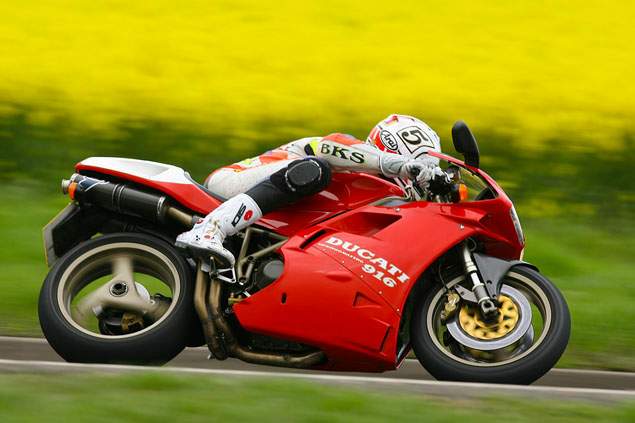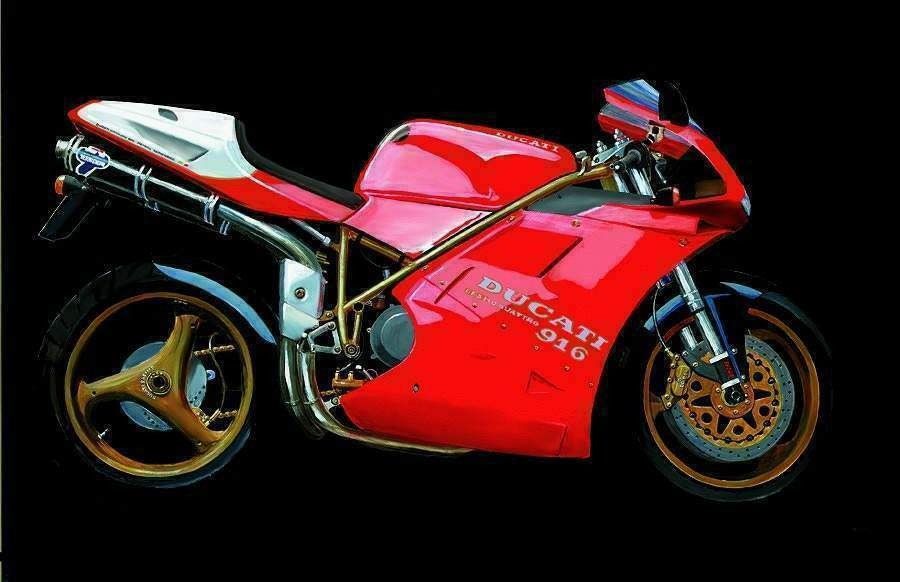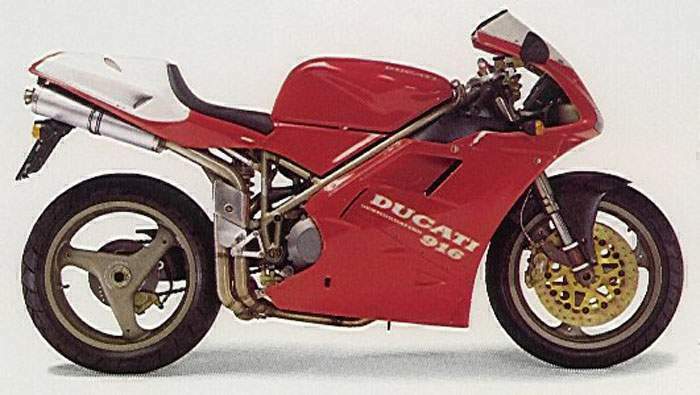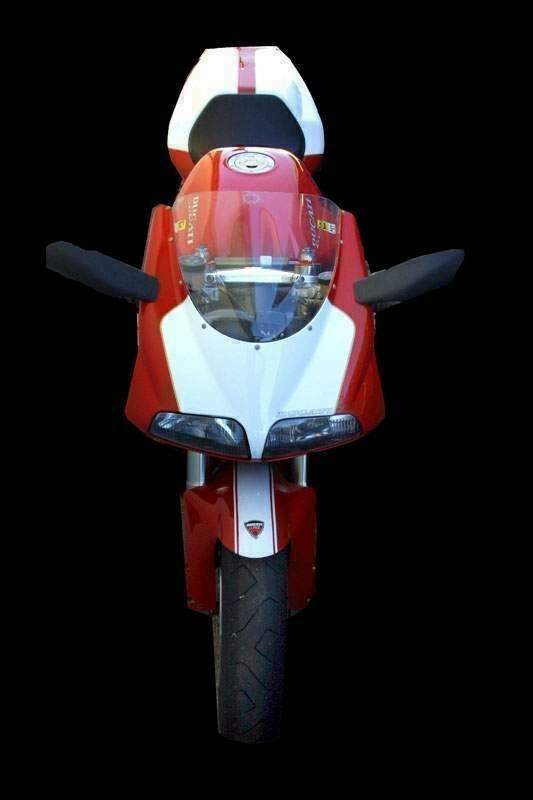
|
|
|
|
|
|
Classic Bikes
Custom Bikes
Individual
Racing Bikes AJP
AJS
Aprilia
Ariel
Avinton / Wakan
Bajaj
Benelli
Beta
Bimota
BMW
Brough Superior
BRP Cam-Am
BSA
Buell / EBR
Bultaco
Cagiva
Campagna
CCM
CF Moto
Combat Motors
Derbi
Deus
Ducati
Excelsior
GASGAS
Ghezzi Brian
Gilera
GIMA
Harley Davidson
Hero
Highland
Honda
Horex
Husaberg
Husqvarna
Hyosung
Indian
Jawa
Kawasaki
KTM
KYMCO
Laverda
Lazareth
Magni
Maico
Mash
Matchless
Mondial
Moto Guzzi
Moto Morini
MV Agusta
MZ / MuZ
NCR
Norton
NSU
Paton
Peugeot
Piaggio
Revival Cycles
Roland Sands
Royal Enfield
Sachs
Sherco
Sunbeam
Suzuki
SWM
SYM
Triumph
TVS
Ural
Velocette
Vespa
Victory
Vincent
VOR
Voxan
Vyrus
Walt Siegl
Walz
Wrenchmonkees
Wunderlich
XTR / Radical
Yamaha
Zero
Video
Technical
Complete Manufacturer List
|
Ducati 916SP
|
| . |
|
Make Model |
Ducati 916 SP / SP2 / SP3 |
|
Year |
1994 - 96 |
|
Engine |
Four stroke, 90° “L” twin cylinder, DOHC, desmodromic 4 valve per cylinder, belt driven |
|
Capacity |
916 cc / 55.9 cu in |
| Bore x Stroke | 94 x 66 mm |
| Cooling System | Liquid cooled |
| Compression Ratio | 11.2:1 |
|
Induction |
Weber I.A.W. CPU P8 electronic indirect injection |
| Spark Plugs | Champion RA59GC |
| Lubrication | Wet sump |
| Engine Oil | Synthetic, 15w-50 |
|
Ignition |
Electronic I.A.W |
| Battery | 12V 16Ah |
| Starting | Electric |
|
Max Power |
96.4 kW / 131 hp @ 10500 rpm |
| Max Torque | 99 Nm / 73 lb-ft @ 700 rpm |
|
Clutch |
Dry, multiplate |
|
Transmission |
6 Speed |
| Primary Drive Ratio | 2:1 (31/62) |
| Gear Ratios | 1st 2.466 / 2nd 1.765 / 3rd 1.350 / 4th 1.091 / 5th 0.958 / 6th 0.857 |
| Final Drive Ratio | 2.57:1 (14/36) |
| Final Drive | Chain |
| Frame | Steel, Trellis frame |
|
Front Suspension |
43 mm Adjustable Showa GD051 inverted fork |
| Front Wheel Travel | 127 mm / 5.0 in |
|
Rear Suspension |
Öhlins DU 3420 progressive cantilever linkage with adjustable monoshock |
| Rear Wheel Travel | 130 mm / 5.1 in |
|
Front Brakes |
2 x 320 mm Discs, 4 piston calipers |
|
Rear Brakes |
Single 220 disc, 2 piston caliper |
|
Front Wheel |
3.50 x 17 |
|
RearWheel |
5.50 x 17 |
|
Front Tyre |
120/70 ZR17 |
|
Rear Tyre |
190/50 ZR17 or 180/55 ZR17 |
| Rake | Adjustable 24o - 25o |
| Trail | 94 - 100 mm / 3.7 - 3.9 in |
|
Dimensions |
Length 2050 mm / 80.7 in Width 685 mm / 27.0 in Height 1090 mm / 42.9 in |
| Wheelbase | 1410 mm / 56.6 in |
| Seat Height | 790 mm / 31.1 in |
|
Dry Weight |
192 kg / 423 lbs |
|
Fuel Capacity |
17 Litres / 4.4 US gal / 3.7 Imp gal |
| Reserve | 4 L / 1.1 IS gal / 0.9 Imp gal |
|
Braking 60 km/h - 0 |
12.5 m / 41 ft |
|
Braking 100 km/h - 0 |
37 m / 121.4 ft |
|
Standing ¼ Mile |
10.4 sec / 219.8 km/h / 136.6 mph |
|
Top Speed |
269.3 km/h / 167.3 mph |
| Manuals | Ducati 916 |
| . |
The SP was introduced in 1994 alongside the Strada. Most of the parts were shared with the standard bike – frame, front forks, brake calipers, wheels, most of the bodywork, and the cooling system were shared with the Strada. Outside of the motor the key difference were a smattering of carbon fibre parts, a Monoposto tail with a white numberplate paint scheme, a set of full floating cast iron brake rotors, and an Ohlins rear shock - which, as per Ducati practice at the time, might have ended up on a Strada anyway if that was all they had lying around in the parts bin on that day. If you were lucky and Giuseppe on the assembly line was feeling generous you might have gotten a carbon fibre airbox. Generally the specs of these mid 90s bikes vary quite a bit just because production was limited by parts supply, and the workers would use whatever bits were available to complete the day’s bikes.
The 916 was more popular than Ducati could have imagined and production was stretched to the limit to meet demand, no mean feat considering a fire at the Bologna paint shop had forced them to move to temporary digs at the Cagiva Varese works.

Ok, at first glance the SP wasn’t that special and could easily be mistaken for a standard model with a few parts from the Performance catalogue. It was only about 6 pounds lighter than the standard Monoposto. What was special was the work done to the motor. While it shared the gearbox, alternator and bore/stroke of the Strada motor, not much else was interchangeable. The crankcases were finished differently and had a rough cast texture, and inside you’d find reinforced main bearings. Look at the cylinder heads and you’d see they were based on the 916 Racing heads, cast without the usual “4V Desmo” text for an extra few millimetres of front wheel clearance.
The clutch pack was unique to the SP, and the final drive was lowered with a 14 tooth front sprocket instead of the 15 tooth of the Strada. A high flow oil pump and forced lubrication to the gudgeon pins improved oil delivery at high RPMs. Con rods were Pankl titanium H-section.
The crankshaft counterweights were lightened considerably. New pistons bumped up the compression ratio a smidge from 11:1 to 11.2:1. Valves were enlarged from 33/29mm to 34/30mm. Heads were ported from the factory. Up top you got G/A cams, some of the hottest camshafts ever fitted to a street legal Desmoquattro.
The fuel injection throttle bodies were borrowed from the 888 SP5 and featured two injectors per cylinder mated to a P8 ECU, with a high-pressure fuel regulator to ensure adequate delivery at high RPM. The exhaust was unique, featuring 45mm headers ala Strada mated to a 50mm half system at the rear.

For 1994 the Strada was claimed to have 114 hp, while the SP had 126. Later revisions dropped the Strada to 109 and the SP up to 131, though no changes were made to either motor. In the real world you could expect the SP to knock out about 10 extra horsies at the rear wheel when put back to back with a Strada – standard 916s typically make 100-105 at the wheel while SPs knock out around 110-115. More important was how the character and power delivery of the motor was changed.
Standard 916s are quite peaky for a big twin. They don’t have much power below 5000 rpm and only really come on the cam around 7000. They are reasonably tractable and can be ridden leisurely, but to make real progress they need to be flogged a bit. The SP is far worse. With lighter internals and very high lift cams, it is a motor that needs to breath hard to make power and it spins up much faster than a Strada. Compare dyno graphs and a standard 916 is far more linear and will beat an SP up until about 6000 rpm, and things get interesting at 8000.
That’s when the SP wakes up and takes off like a scalded cat up to redline. It's just like a normal 916, but turned up to 11. It makes for a more frenetic riding experience, but it also makes the SP feel a bit disappointing in everyday riding. It doesn’t feel considerably faster than a Strada/Biposto until you hammer it into the higher revs, and the everyday rideability is compromised by the extreme camshafts and lighter internals.

Handling is otherwise more or less the same as the standard bike. The Ohlins rear shock was a big improvement over the standard Showa unit and helped to improve roadholding and compliance quite a bit, but the basic characteristics of the 916 remained intact – which is good, because it was one of the finest handling machines of the time. Braking was improved slightly by the cast iron rotors, but the SP1 retained the mushy rubber brake lines of the Strada - later years got stainless lines to improve feel.
310 SP1s were produced in 1994. 1995 saw the production of the SP2, which was largely unchanged - some sources claimed the expensive titanium con rods were dropped in favour of steel items, but this wasn’t universal. Another 401 examples were built. 1996 was the final year, with 497 SP3s rolling off the line.
Source Odd Bike

|
Any corrections or more information on these motorcycles will be kindly appreciated. |